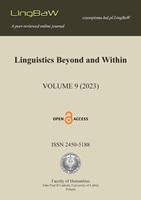Subject-Object binding dependencies in Romanian
Subject-Object binding dependencies in Romanian
Author(s): Alina TigăuSubject(s): Semantics, Sociolinguistics, Descriptive linguistics, Theory of Communication, Stylistics
Published by: Wydawnictwo KUL
Keywords: binding; c-command; clitic doubling; differential object marking; direct object;
Summary/Abstract: This paper dwells on an interesting contrast between Romance (Romanian, Spanish a.o.) and Germanic languages (English, German a.o.) with respect to the syntax and the interpretation of the direct object (DO). One structural difference between these two groups of languages amounts to the fact that the former clitic double (CD) and differentially object mark (DOM) their direct objects while the latter do not. This leads to important interpretive consequences when it comes to phenomena such as Subject-Object binding dependences: Non-CD languages rely on the c-command configuration and surface word order in resolving binding relations (the antecedent must ccommand the element containing the bound pronoun. As a consequence, a natural way for the DO to bind into the Subject is to have it moved to the left, in a preceding, c-commanding position). As will be shown, in CD languages, the word order configuration is not decisive: the direct object may bind the subject without having to precede it at the same time. The paper draws a parametric difference between configurational languages (where binding is closely linked to the c-command configurations and is sensitive to surface word order) and nonconfigurational languages, where the same semantic properties can be derived from the internal structure of the direct object (through its featural specification).
Journal: Linguistics Beyond and Within (LingBaW)
- Issue Year: 9/2023
- Issue No: 9
- Page Range: 208-223
- Page Count: 16
- Language: English

